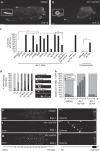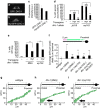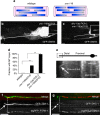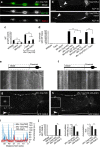Local inhibition of microtubule dynamics by dynein is required for neuronal cargo distribution
- PMID: 28406181
- PMCID: PMC5399302
- DOI: 10.1038/ncomms15063
Local inhibition of microtubule dynamics by dynein is required for neuronal cargo distribution
Abstract
Abnormal axonal transport is associated with neuronal disease. We identified a role for DHC-1, the C. elegans dynein heavy chain, in maintaining neuronal cargo distribution. Surprisingly, this does not involve dynein's role as a retrograde motor in cargo transport, hinging instead on its ability to inhibit microtubule (MT) dynamics. Neuronal MTs are highly static, yet the mechanisms and functional significance of this property are not well understood. In disease-mimicking dhc-1 alleles, excessive MT growth and collapse occur at the dendrite tip, resulting in the formation of aberrant MT loops. These unstable MTs act as cargo traps, leading to ectopic accumulations of cargo and reduced availability of cargo at normal locations. Our data suggest that an anchored dynein pool interacts with plus-end-out MTs to stabilize MTs and allow efficient retrograde transport. These results identify functional significance for neuronal MT stability and suggest a mechanism for cellular dysfunction in dynein-linked disease.
Conflict of interest statement
The authors declare no competing financial interests.
Figures







Similar articles
-
Regulators of the actin cytoskeleton mediate lethality in a Caenorhabditis elegans dhc-1 mutant.Mol Biol Cell. 2010 Aug 1;21(15):2707-20. doi: 10.1091/mbc.E09-07-0593. Epub 2010 Jun 16. Mol Biol Cell. 2010. PMID: 20554764 Free PMC article.
-
Two populations of cytoplasmic dynein contribute to spindle positioning in C. elegans embryos.J Cell Biol. 2017 Sep 4;216(9):2777-2793. doi: 10.1083/jcb.201607038. Epub 2017 Jul 24. J Cell Biol. 2017. PMID: 28739679 Free PMC article.
-
The Caenorhabditis elegans JIP3 protein UNC-16 functions as an adaptor to link kinesin-1 with cytoplasmic dynein.J Neurosci. 2011 Feb 9;31(6):2216-24. doi: 10.1523/JNEUROSCI.2653-10.2011. J Neurosci. 2011. PMID: 21307258 Free PMC article.
-
Mechanism and regulation of cytoplasmic dynein.Annu Rev Cell Dev Biol. 2015;31:83-108. doi: 10.1146/annurev-cellbio-100814-125438. Epub 2015 Sep 30. Annu Rev Cell Dev Biol. 2015. PMID: 26436706 Free PMC article. Review.
-
Distinct functional roles of cytoplasmic dynein defined by the intermediate chain isoforms.Exp Cell Res. 2015 May 15;334(1):54-60. doi: 10.1016/j.yexcr.2014.12.013. Epub 2015 Jan 6. Exp Cell Res. 2015. PMID: 25576383 Free PMC article. Review.
Cited by
-
Dynein promotes sustained axonal growth and Schwann cell remodeling early during peripheral nerve regeneration.PLoS Genet. 2019 Feb 19;15(2):e1007982. doi: 10.1371/journal.pgen.1007982. eCollection 2019 Feb. PLoS Genet. 2019. PMID: 30779743 Free PMC article.
-
Contributions of microtubule dynamics and transport to presynaptic and postsynaptic functions.Mol Cell Neurosci. 2022 Dec;123:103787. doi: 10.1016/j.mcn.2022.103787. Epub 2022 Oct 14. Mol Cell Neurosci. 2022. PMID: 36252720 Free PMC article.
-
IGF1R regulates retrograde axonal transport of signalling endosomes in motor neurons.EMBO Rep. 2020 Mar 4;21(3):e49129. doi: 10.15252/embr.201949129. Epub 2020 Feb 7. EMBO Rep. 2020. PMID: 32030864 Free PMC article.
-
NudC regulated Lis1 stability is essential for the maintenance of dynamic microtubule ends in axon terminals.iScience. 2022 Sep 5;25(10):105072. doi: 10.1016/j.isci.2022.105072. eCollection 2022 Oct 21. iScience. 2022. PMID: 36147950 Free PMC article.
-
Neurexin and frizzled intercept axonal transport at microtubule minus ends to control synapse formation.Dev Cell. 2022 Aug 8;57(15):1802-1816.e4. doi: 10.1016/j.devcel.2022.06.009. Epub 2022 Jul 8. Dev Cell. 2022. PMID: 35809561 Free PMC article.
References
-
- Conde C. & Caceres A. Microtubule assembly, organization and dynamics in axons and dendrites. Nat. Rev. Neurosci. 10, 319–332 (2009). - PubMed
-
- Janke C. & Kneussel M. Tubulin post-translational modifications: encoding functions on the neuronal microtubule cytoskeleton. Trends Neurosci. 33, 362–372 (2010). - PubMed
-
- Kapitein L. C. & Hoogenraad C. C. Building the neuronal microtubule cytoskeleton. Neuron 87, 492–506 (2015). - PubMed
-
- Coles C. H. & Bradke F. Coordinating neuronal actin-microtubule dynamics. Curr. Biol. 25, R677–R691 (2015). - PubMed
-
- Millecamps S. & Julien J. P. Axonal transport deficits and neurodegenerative diseases. Nat. Rev. Neurosci. 14, 161–176 (2013). - PubMed
Publication types
MeSH terms
Substances
LinkOut - more resources
Full Text Sources
Other Literature Sources
Research Materials

